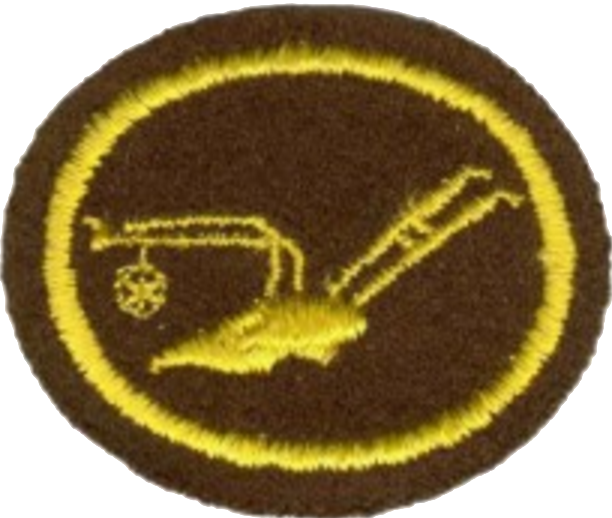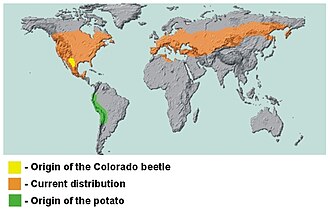AY Honors/Agriculture
| Agriculture | |
|---|---|
| Outdoor Industries | |
Skill Level 123 | |
Approval authority General Conference | Year of Introduction 1929 |
See also | |
AY Honors/Agriculture/Overview
The most challenging requirement of this honor is probably this:
8. Assist in planting, cultivating, and harvesting at least four different crops. Maintain a log of work done and problems encountered from seeding to harvest.
1. List the components of soil. Why is soil important to plants?
2. Explain the difference between clay, sand, and loam soils. List three crops that grow well in each.
3. Test the germination of three varieties of seeds, 100 seeds in each variety. Record germination percentage after three, four, and five days.
4. Explain how plants obtain nutrients and convert them into food. Explain the differences between primary, secondary, and micronutrients.
5. Name and identify ten common weeds of your community and tell how to best eliminate them, using cultural or chemical methods.
6. Identify six common insect pests or diseases. Tell what plants they usually affect and how to eliminate or prevent their occurrence.
7. Locate two sources of agricultural weather information. How is this information helpful to the farmer?
8. Assist in planting, cultivating, and harvesting at least four different crops. Maintain a log of work done and problems encountered from seeding to harvest.
9. Know the purpose of the following:
- a. Plowing
- b. Disking
- c. Cultivating
- d. Irrigation
- e. Harvesting
10. Name and identify ten common birds of your locality, and state their value to the farmer.
11. What is erosion? How can it be prevented?
12. Visit your local cooperative extension service and find out how the organization helps the farmer. Write a one-page report of your visit.
1
You should consider doing the Soil Honor found in the Nature category at the same time, as these requirements overlap significantly.
Soil Components
Soil has three components: solid, liquid, and gas. The solid phase is a mixture of mineral and organic matter. Soil particles pack loosely, forming a soil structure filled with voids. The solid phase occupies about half of the soil volume. The remaining void space contains water (liquid) and air (gas).
Soil texture refers to sand, silt and clay composition. Sand and silt are the product of physical weathering while clay is the product of chemical weathering. Clay content is particularly influential on soil behavior due to a high retention capacity for nutrients and water.
Importance to Plants
Soil provides minerals and water to plants. Soil absorbs rainwater and releases it later, thus preventing floods and drought. Soil cleans the water as it percolates. Soil is the habitat for many organisms.
2
- Clay
- Clay soils are made from very fine particles which stick together easily. Water does not easily soak through clay soils, but once it penetrates, the clay holds it well. It must be broken up before it can be used for agriculture. This can be done by mixing it with sand, sawdust, wood chips, lime, or manure. Crops that grow well in clay soils include celery, wheat, oats, beans, and clover.
- Sand
- Sandy soils are made from coarse particles. Water soaks into sand quickly, but will not remain there for very long. This can be addressed by adding clay soil to it. Crops that grow well in sandy soil include melons, cucumbers, peaches, peanuts, and beans.
- Loam
- Loam is soil composed of sand, silt, manure, and clay in a relatively even concentration (about 40-40-10-10% concentration respectively). Loams are gritty, plastic when moist, and retain water easily. They generally contain more nutrients than sandy soils. In addition to the term loam, different names are given to soils with slightly different proportions of sand, silt, manure and clay: sandy loam, silty loam, clay loam, sandy clay loam, silty clay loam, and manural loam. Loam soil is ideal for growing crops because it retains nutrients well and retains water while still allowing the water to flow freely. This soil is found in a majority of successful farms in regions around the world known for their fertile land. Crops that do well in loamy soil include barley, turnips, and potatoes.
3
First, wrap each variety seeds in a paper towel. Then dampen the paper towels and place them each inside their own clear plastic bag (such as a sandwich bag or a freezer bag) so that they retain moisture. Do not seal the bags. Set the bags in a warm place. After three days, carefully remove the paper towel from each bag, open it, and count the number of seeds that have sprouted. If you started with 100 seeds as per this requirement, the germination percentage will equal the number of seeds that have sprouted. Write this percentage down for each variety.
Do not remove the sprouted seeds. Rewrap the seeds in the paper towels, place the paper towels back in the bags, and return them to the warm place. Repeat after day four and day five.
The Seeds-Advanced Honor has a similar requirement so consider tackling these honors together.
4
Fertilizers can be divided into macronutrients or micronutrients based on their concentrations in plant dry matter. There are six macronutrients: nitrogen, phosphorus, potassium, calcium, magnesium, and sulfur. Nitrogen, phosphorus, and potassium are often termed "primary macronutrients" because their availability is usually managed with NPK fertilizers. The "secondary macronutrients" — calcium, magnesium, and sulfur are required in roughly similar quantities, but their availability is often managed as part of liming and manuring practices rather than fertilizers. The macronutrients are consumed in larger quantities and normally present as a whole number or tenths of percentages in plant tissues (on a dry matter weight basis). There are many micronutrients (such as boron, chlorine, manganese, iron, zinc, copper, and molybdenum), required in concentrations ranging from 5 to 100 parts per million (ppm) by mass.
The uptake of nutrients by plants is accomplished through both the roots and the leaves. These nutrients are then used in the process of photosynthesis, which is a complex chemical reaction that converts light, carbon dioxide, and water into sugars.
5
Chenopodium album
| Chenopodium album (Fat hen) | |
|---|---|
|
Where found: Worldwide
Description: Chenopodium album is a fast-growing weedy annual plant in the genus Chenopodium. The standard English name is Fat-hen; other names include white goosefoot, lamb's quarters, pigweed or dungweed, or more ambiguously as just goosefoot.
Control: It may be controlled by dark tillage, rotary hoeing, or flaming when the plants are small. Crop rotation of small grains will suppress an infestation. It is, however, difficult to control with chemical means.
|
 |
Stellaria
| Stellaria (Chickweed) | |
|---|---|
|
Where found: Europe, North America
Description: Stellaria is a genus of about 90-120 species flowering plants in the family Caryophyllaceae, with a cosmopolitan distribution. Common names include stitchwort and chickweed.
Control: Control is difficult due to the heavy seed sets, although herbicides are effective when the plants are small. Common Chickweed is very competitive with small grains, and can produce up to 80% yield losses among barley.
|
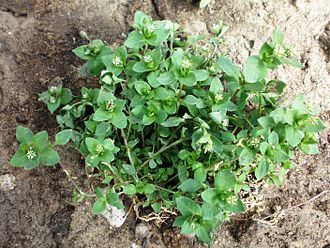 |
Ranunculus ficaria
| Ranunculus ficaria (Lesser celandine) | |
|---|---|
|
Where found: The plant is found throughout Europe and west Asia. Now introduced in North America.
Description: The window of opportunity for controlling lesser celandine is very short, due to its life cycle. In order to have the greatest negative impact to celandine and the least impact to desirable native wildflower species, herbicide should be applied in late winter-early spring (March-May). Apply a 1.5% rate of a 39 to 41% glyphosate isopropylamine salt (e.g., Rodeo® for wetland areas) mixed with water and a non-ionic surfactant to foliage, avoiding application to anything but the celandine. Glyphosate is systemic; that is, the active ingredient is absorbed by the plant and translocated to the roots, eventually killing the entire plant. The full effect on the plant may take 1-2 weeks. Applications can be made during the winter season as long as the temperature is above about 50 degrees Fahrenheit, and no rain is anticipated within 12 hours. Because glyphosate is non-specific, spray should be controlled such that it touches only lesser celandine and does not drift onto desirable plants. To minimize impact to sensitive-skinned frogs and salamanders, some experts recommend applying herbicide in March and then switching to manual methods.
|
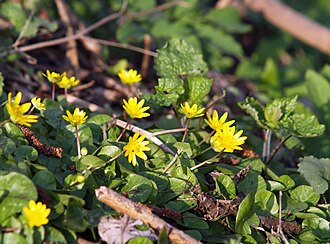 |
Oxalis
| Oxalis (Wood sorrel) | |
|---|---|
|
Where found: The genus occurs throughout most of the world, except for the polar areas; species diversity is particularly rich in tropical Brazil and Mexico and in South Africa.
Description: Oxalis is the largest genus in the wood sorrel family Oxalidaceae. Of the approximately 900 known species in the Oxalidaceae, 800 belong to Oxalis. Many of the species are known as Wood Sorrel or Woodsorrel. These plants are annual or perennial. The leaves are divided into three to ten or more round, heart-shaped or lanceolate leaflets, arranged in a whorl with all the leaflets of roughly equal size. The majority of species have three leaflets. In these species, the leaves are superficially similar to those of some clovers, though clovers differ in having the leaflets not in a whorl, and of unequal size with two smaller side leaflets and one larger central leaflet.
Control: Diuron has potential for use as an over-the-top application for postemergence oxalis control, and timely irrigation has the potential to reduce injury to sensitive crops.
|
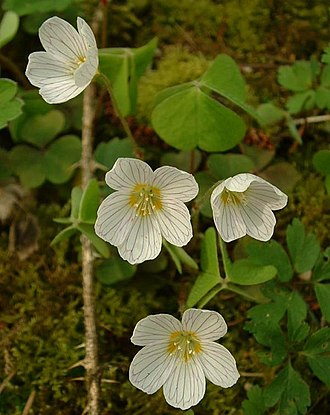 |
Elytrigia repens
| Elytrigia repens (Couch Grass) | |
|---|---|
|
Where found: Elytrigia repens is a very common species of grass native to most of Europe, Asia, and northwest Africa.
Description: Other names include twitch, quick grass, quitch grass, dog grass, and quackgrass.
It has creeping rhizomes which enable it to grow rapidly across grassland. The stems ('culms') grow to 40–150 cm tall; the leaves are linear, 15–40 cm long and 3–10 mm broad at the base of the plant, with leaves higher on the stems 2–8.5 mm broad. The flower spike is 10–30 cm long, with spikelets 1–2 cm long, 5–7 mm broad and 3 mm thick with three to eight florets. The glumes are 7–12 mm long, usually without an awn or with only a short one.
Control: Couch Grass is very difficult to remove from garden environments. One method is to dig deep into the ground in order to remove as much of the grass as possible. The area should then be covered with a thick layer of woodchips. To further prevent re-growth cardboard can be placed underneath the woodchips. The long, white rhizomes will, however, dry out and die if left on the surface.
|
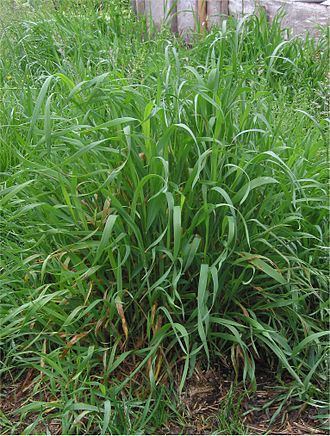 |
Ranunculus repens
| Ranunculus repens (Creeping Buttercup) | |
|---|---|
|
Where found: Native to Europe, Asia and northwestern Africa. Introduced to North America.
Description: Creeping Buttercup is a herbaceous, stoloniferous perennial plant growing to 50 cm tall. It has both prostrate running stems, which produce roots and new plants at the nodes, and more or less erect flowering stems. The basal leaves are divided into three broad leaflets 1.5–8 cm long, shallowly to deeply lobed, borne on a 4–20 cm long petiole; leaves higher on the stems are smaller, with narrower leaflets. Both the stems and the leaves are finely hairy. The flowers are bright golden yellow, 2–3 cm diameter, usually with five petals. The fruit is a cluster of achenes 2.5–4 mm long. Creeping buttercup has three-lobed dark green, white-spotted leaves that grow out of the node. It grows in fields and pastures and prefers wet soil.
Control: From the USDA
|
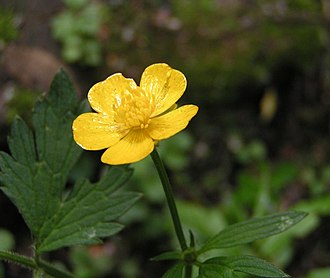 |
Sinapis arvensis
| Sinapis arvensis (Charlock) | |
|---|---|
|
Where found: Native to Europe. Naturalized throughout much of North America.
Description: Charlock, also known as wild mustard, is an annual or winter annual up to 1 m tall. The stems are erect with coarse spreading hairs near the base. The basal leaves are pinnatifid to dentate. The cauline leaves are much reduced and are short petiolate to sessile but not auriculate-clasping. The inflorescence is a raceme made up of yellow flowers having four petals. The fruit is a silique 3-5 cm long with a beak 1-2 cm long that is flattened-quadrangular. The valves of the silique are glabrous or rarely bristly, three to five nerved. The seeds are smooth 1-1.5 mm in diameter.
Control: Can be controlled by tilling the affected areas.
|
 |
Senecio vulgaris
| Senecio vulgaris (Common groundsel) | |
|---|---|
|
Where found: A tenacious deciduous annual, whose presence now encompasses the globe in a wide area of easy to somewhat difficult growing conditions.
Description: Standing only between 4 and 16 inches (10 to 41 cm) tall, bright florets mostly hidden by the characteristic bract giving it the appearance of never opening flowers and with a life span of 5-6 weeks. The self fertilizing Senecio vulgaris lives humbly among and occasionally under the other weeds and is easy to not notice.
Control: The ragwort flea beetle and ragwort seed fly have been approved and released for Senecio control in California, Australia and elsewhere.
|
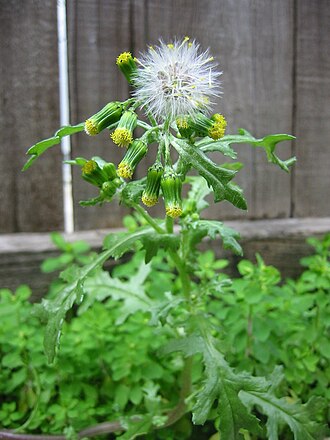 |
Galium aparine
| Galium aparine (Cleavers, Bedstraw) | |
|---|---|
|
Where found: Native to North America and Eurasia.
Description: The long stems of this climbing plant sprawl over the ground and other plants, reaching heights of 1-1.5 m, occasionally 2 m. The leaves are simple and borne in whorls of six to eight. Both leaves and stem have fine hairs tipped with tiny hooks, making them cling to clothes and fur much like velcro. The white to greenish flowers are 2-3 mm across, with four petals.
Control: Cleavers, or Bedstraw, tends to grow in uncultivated areas, such as beneath fence lines and at the edges of fields. The main problem it presents to agriculture is that it clogs harvesting machinery. It is best controlled before it is allowed to propagate into cultivated fields by mechanical means, or by livestock.
|
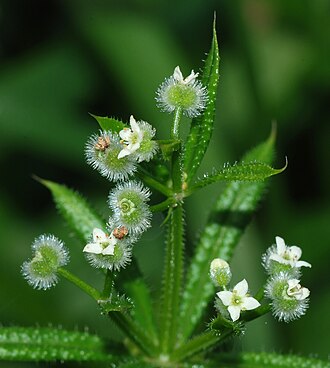 |
Cardamine hirsuta
| Cardamine hirsuta (Hairy bittercress) | |
|---|---|
|
Where found: Native to Europe and Asia, but also present in North America as an invasive weed.
Description: The plant is a member of the mustard family (Brassicaceae), and is edible as a bitter herb. It flowers from quite early in the Spring until the Autumn. The small white flowers are borne in a corymb on wiry green stems, soon followed by seeds and often continuing to flower as the first seeds ripen. The seed will burst explosively, often when touched, sending the seeds flying far from the parent plant. Seeds germinate in the Autumn, and the plants are green throughout the winter months.
Control:
|
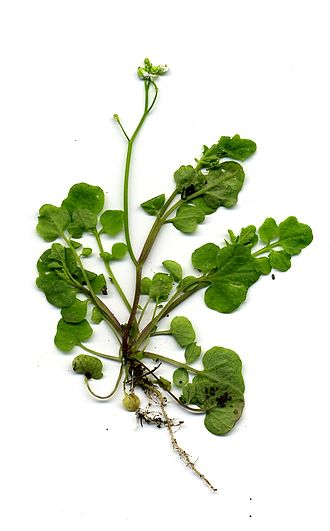 |
Rumex
| Rumex (Dock) | |
|---|---|
|
Where found: Members of this family are very common perennial herbs growing in acidic, sour soils mainly in the northern hemisphere, but have been introduced almost everywhere.
Description: These are erect plants with long tap roots. The fleshy to leathery leaves form a basal rosette at the root. The basal leaves may be different from those near the inflorescence. They may or may not have stipules. There are minor leaf veins. The leaf blade margins are entire or crenate.
Control: Keeping fields well drained will help control dock. Young plants may be controlled by cultivation, but because mature plants send tap roots deep into the soil, it is difficult to eradicate them this way. Chemical controls include applying a combination of glyphosate and dicamba via a wiper when the plants are at least 30cm higher than the crops in which they grow.
|
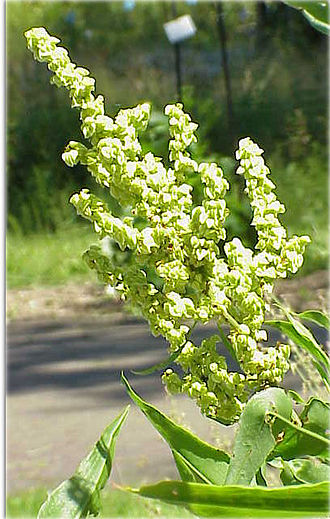 |
Taraxacum
| Taraxacum (Dandelion) | |
|---|---|
|
Where found: Dandelions are native to Africa, Asia and Europe, and have been widely introduced elsewhere. Dandelions have become established in the Americas, Australia and New Zealand and are now common throughout all temperate regions.
Description: The leaves are 5-25 cm long, simple and basal, entire or lobed, forming a rosette above the central taproot. As the leaves grow outward they push down the surrounding vegetation, such as grass in a lawn, which kills other plants by cutting off their access to sunlight. A bright yellow flower head (which is open in the daytime but closes at night) is borne singly on a hollow stem (scape) which rises 4-30 cm above the leaves and exudes a milky sap (latex) when broken. A rosette may produce several flowering stems at a time. The flower head is 2-5 cm in diameter and consists entirely of ray florets. The flower head matures into a spherical "clock" containing many single-seeded fruits (achenes). Each achene is attached to a pappus of fine hairs, which enable wind-dispersal over long distances.
Control: Dandelion seeds are windborne, so it is difficult to prevent an infestation. If possible, dig the plants up at the edge of a field before they produce seeds. Otherwise, chemical controls may be necessary. Glyphosate, mecoprop, and other herbicides can be applied to young plants. 2, 4-D is effective against established infestations.
|
 |
Calystegia
| Calystegia (Bindweed, Morning Glory) | |
|---|---|
|
Where found: The genus has a cosmopolitan distribution in temperate and subtropical regions, but with half of the species endemic to California
Description: Bindweed are annual or herbaceous perennial twining vines growing to 1-5 m tall, with spirally arranged leaves. The flowers are trumpet shaped, 3-10 cm diameter, white or pink, with a sometimes inflated basal calyx. Some of the species, notably C. silvatica, are problematic weeds, which can swamp other more valuable plants by climbing over them, but some are also deliberately grown for their attractive flowers.
Control: Bindweed is difficult to control once it becomes established. It is a very persistent weed, so control methods must necessarily be more persistent.
Bindweed should be tilled under about eight days following emergence. It will re-emerge, so it will need to be retilled several times during the growing season. A systemic herbicide can also be used, such as 2,4-D or glyphosate. These herbicides must move in sufficient amounts through the roots, stems, and leaves in order to be effective. |
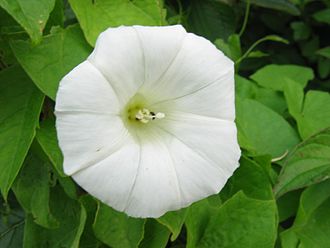 |
Urtica
| Urtica (Nettle) | |
|---|---|
|
Where found: Urtica has a cosmopolitan though mainly temperate distribution. The most prominent member of the genus is the stinging nettle Urtica dioica, native to Europe, north Africa, Asia, and North America.
Description: This species have spiny hairs, or stinging trichomes, whose tips come off when touched, transforming the hair into a needle that will inject a cocktail of poisons: acetylcholine, histamine, 5-HT and possibly formic acid. This mix of poisons cause a sting or paresthesia from which the species derives its common name, as well as the colloquial name "7 minute itch".
Control: Nettles should be trimmed to the ground and then sprayed with glyphosate. If the re-emerge, they should quickly be hit with glyphosate a second time.
|
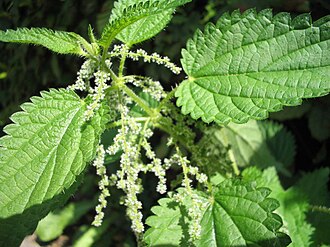 |
Polygonum cuspidatum
| Polygonum cuspidatum (Japanese knotweed) | |
|---|---|
|
Where found: Japanese knotweed is native to eastern Asia in Japan, China and Korea. In the U.S.A. and Europe the species is very successful and has been classified as invasive in several countries.
Description: A member of the family Polygonaceae, Japanese knotweed has hollow stems with distinct raised nodes that give it the appearance of bamboo, though it is not related. While stems may reach a maximum height of 3–4 m each growing season, it is typical to see much smaller plants in places where they sprout through cracks in the pavement or are repeatedly cut down. The leaves are broad oval with a truncated base, 7–14 cm long and 5–12 cm broad, with an entire margin. The flowers are small, creamy white, produced in erect racemes 6–15 cm long in late summer and early autumn.
Control: The success of the species has been partially attributed to its tolerance of a very wide range of soil types, pH and salinity.[2] Its rhizomes can survive temperatures of −35 °C (−30 °F) and can extend 7 meters (23 ft) horizontally and 3 meters (9.8 ft) deep, making removal by excavation difficult. The most effective method of control is by herbicide application close to the flowering stage in late summer or autumn. In some cases it is possible to eradicate Japanese knotweed in one growing season using only herbicides.
|
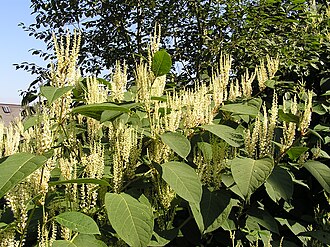 |
Cirsium arvense
| Cirsium arvense (Creeping thistle) | |
|---|---|
|
Where found: Native throughout Europe and northern Asia, and widely introduced elsewhere.
Description: It is a tall herbaceous perennial plant, forming extensive clonal colonies from an underground root system that sends up numerous erect stems each spring, reaching 1–1.2 m tall (occasionally more); the stems often lie partly flat by summer but can stay erect if supported by other vegetation. The leaves are very spiny, lobed, up to 15–20 cm long and 2–3 cm broad (smaller on the upper part of the flower stem). The inflorescence is 10–22 mm diameter, pink-purple, with all the florets of similar form (no division into disc and ray florets).
Control: This plant is extremely difficult to control, as it can regrow from fairly small root fragments and is resistant to many herbicides.
|
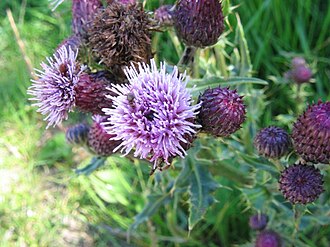 |
6
Slug
| Limax maximus (Great Grey Slug) | |
|---|---|
|
Where found: Native to Europe, the slugs have been introduced to Northern America and occur along the East and West sides of that continent. The slugs are almost always found near human habitation — usually in lawns, gardens, cellars or in other damp areas.
Description: The Great Grey Slug, Limax maximus (literally, "great slug"), also known as the Tiger slug or the Spotted leopard slug, is one of the largest kinds of keeled slug (second only to Limax cinereoniger). The species is noted for its dark-spotted pale-grey body and the short keel on its tail. These nocturnal animals can grow to be as long as 8 inches (20 cm), feeding mostly on rotting plant matter and fungi. They live for up to three years and are inactive during the winter.
Affected crops: Lettuce and cabbage are their favorites, but they will eat about anything.
Control: Diatomite is a naturally occurring, soft, chalk-like sedimentary rock that is easily crumbled into a fine white to off-white powder. It is sometimes used as an insecticide, due to its physico-sorptive properties. The fine powder absorbs lipids from the cuticle, the waxy outer layer of insects' exoskeletons, causing them to dehydrate. This also works against gastropods and is commonly employed in gardening to defeat slugs. However, since slugs inhabit humid environments, efficacy is very low. It is sometimes mixed with an attractant or other additives to increase its effectiveness.
Among the disadvantages of using diatomaceous earth for pest control include the health risk to humans (see below), and that it is harmful to the many insects that are beneficial to gardens, including predatory beetles and bugs and many detritivores (such as earthworms). One mechanical control is to cut a soda bottle in half and place it around the plants to keep slugs out. This is obviously labor intensive, and is therefore not practical for large crops. |
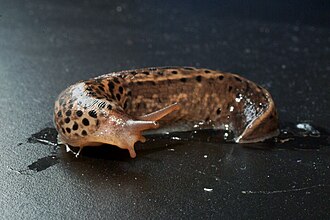 |
Colorado potato beetle
| Leptinotarsa decemlineata (Colorado potato beetle) | |
|---|---|
|
Where found: Native to the Southwestern USA and Mexico, the Colorado potato beetle spread through the rest of the country, and into much of Canada. It then spread to continental Europe and Asia.
Description: The Colorado potato beetle (Leptinotarsa decemlineata, also known as the Colorado beetle, ten-striped spearman, the ten-lined potato beetle) is an important pest of potato crops. It is approximately 10 mm (0.4 inches) long, with a bright yellow/orange body and 5 bold brown stripes along the length of each of its elytra, and it can easily be confused with its close cousin and look-alike, the false potato beetle
Affected crops: Potato, tomato, eggplant, pepper
Control: Insecticides are often unsuccessful when used against Leptinotarsa because of the beetle's resistance to toxins and ability to rapidly develop resistance to them. The Colorado beetle has developed resistance to all major insecticide classes. In areas where the CPB has not developed resistance to pesticides, it is crucially important to not repeated reuse the same type of chemical control, or the CPB will develop resistance to it.
The CPB can be hand picked from the plants. Crop rotation is another effective strategy, the key being to put next year's potato crop as far as possible from last year's crop. Plants can also be covered with floating row covers - a thin fabric which allows moisture and air to circulate, but prevents access to the plants by the beetle.
|
 |
Japanese beetle
| Popillia japonica (Japanese beetle) | |
|---|---|
|
Where found: As the name suggests, the Japanese beetle is native to Japan. The insect was first found in the United States in 1916 in a nursery near Riverton, New Jersey. It is thought that beetle larvae entered the United States in a shipment of iris bulbs prior to 1912 when inspections of commodities entering the country began.
Description: The Japanese beetle (Popillia japonica) is a beetle about 1.5 cm (0.6 inches) long and 1 cm (0.4 inches) wide (smaller in Canada), with shiny copper-colored elytra and a shiny green top of the thorax and head. It is not very destructive in Japan, where it is controlled by natural enemies, but in America it is a serious pest.
Affected crops: Rose bushes, grapes, canna, crape myrtles, squash, strawberries, tomatoes, peppers, grapes, plums, pears, peaches, raspberries, blackberries, corn, peas and other plants.
Control: During the larval stage, the Japanese beetle lives in lawns and other grasslands, where it eats the roots of grass. During that stage, it is susceptible to a fatal disease called milky spore disease, caused by a bacterium called milky spore, Paenibacillus (formerly Bacillus) popilliae. The USDA developed this biological control and it is commercially available in powder form for application to lawn areas. Standard applications (low density across a broad area) take from one to five years to establish maximal protection against larval survival (depending on climate), expanding through the soil through repeated rounds of infection, in-host multiplication, release from killed host, and infection. Typically proper application can lead to a 15-20 year period of protection.
On field crops such as squash, floating row covers can be used to exclude the beetles, however this may necessitate hand pollination of flowers. Kaolin sprays can also be used as barriers. Research performed by many US extension service branches has shown that pheromone traps may attract more beetles than they catch, and so they have fallen out of favor. Natural repellents include catnip, chives, garlic, and tansy, as well as the remains of dead beetles. |
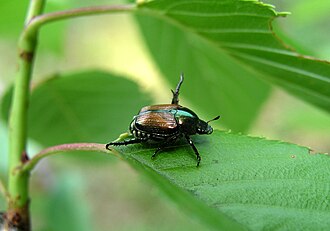 |
European corn borer
| Ostrinia nubilalis (European corn borer) | |
|---|---|
|
Where found: Native to Europe although it is found in North America as well
Description: The European Corn Borer (Ostrinia nubilalis) is a pest of corn. Female corn borer moths lay clusters of eggs on corn leaves, usually on the underside of the leaf.
The egg masses, or clusters, are laid in an overlapping configuration and are whitish-yellow in color. As the larvae develop inside their eggs, the eggs become more and more transparent and the immature caterpillar's black head is eventually visible. The caterpillars hatch by chewing their way out of the eggs. European corn borer caterpillars damage the ears of corn, as well as the stalks, chewing tunnels which cause the plants to fall over.Affected crops: Corn
Control: Biological control agents of corn borers include the hymenopteran parasitoid Trichogramma.
|
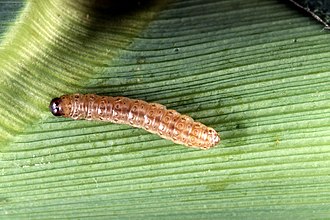 |
Boll weevil
| Anthonomus grandis (Boll weevil) | |
|---|---|
|
Where found: Thought to be native to Central America, it migrated into the US from Mexico in the late 19th century and had infested all US cotton-growing areas by the 1920s, devastating the industry and the people working there and traumatizing the people of the American south. During the late 20th century it became a serious pest in South America as well.
Description: The boll weevil (Anthonomus grandis) is a beetle measuring an average length of six millimeters, which feeds on cotton buds and flowers.
Affected crops: Cotton
Control: The Boll Weevil Eradication Program is a program sponsored by the United States Department of Agriculture (USDA) that has sought to eradicate the boll weevil in the cotton-growing areas of the United States. It is one of the world's most successful implementations of integrated pest management. Three main techniques are employed over a 3- to 5-year period: pheromone traps for detection, cultural practices to reduce the weevil’s food supply, and malathion treatments. During the first year, applications of malathion are made every five to seven days starting in late summer. The frequency is reduced to every 10 days during the later part of the growing season until the first frost. The cotton stalks are shredded and plowed into the ground to eliminate their use as a winter shelter. During years 2 through 5, the automatic spraying is supplemented by an intensive trapping program (one trap per 1-2 acres), and malathion applications are made only in those fields where weevils are detected. This phase begins in late spring and continues until the first killing frost. The final phase of the program involves monitoring and trapping at a density of one trap per 10 acres, with spot spraying as required. The program has become more high-tech in recent years, employing GPS mapping technology and bar code readers that transmit trap data electronically.
|
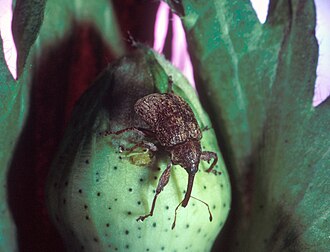 |
Cutworm
| Noctuidae (Cutworm) | |
|---|---|
|
Where found: Their distribution is worldwide.
Description: The term cutworm is used for the larvae of many species of moth. Most cutworms are in the moth family Noctuidae, however, many noctuid larvae are not cutworms. Cutworms are notorious agricultural and garden pests. They are voracious leaf, bud, and stem feeders and can destroy entire plants. They get their name from their habit of "cutting" off a seedling at ground level by chewing through the stem. Some species are subterranean and eat roots. Cutworms are usually green, brown, or yellow soft-bodied caterpillars, often with longitudinal stripes, up to one inch in length. There are many variations across the genera.
Affected crops: Most often tomato, pepper, pea, or bean
Control: While there are pesticides which can control these insects, the non-industrial gardener can protect threatened plants by simply impeding the ground-hiding cutworm caterpillar from climbing the plant; they hide in the soil near the plants and climb them at night.
To prevent this, one can:
|
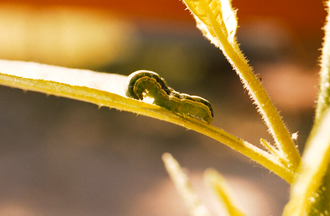 |
Brown marmorated stink bug
| Halyomorpha halys (Brown marmorated stink bug) | |
|---|---|
|
Where found: The brown marmorated stink bug is believed to have "hitched a ride" to the United States as a stowaway in packing crates from Asia; it was accidentally introduced there from China or Japan. Its native range also includes Korea and Taiwan.
Description: Looks similar in appearance to other native species of shield bugs including Acrosternum, Euschistus, and Podisus, except that several of the abdominal segments protrude from beneath the wings and are alternatively banded with black and white (visible along the edge of the bug even when wings are folded) and a white stripe or band on the next to last (4th) antennal segment. The adults are approximately 5/8 inch long and the underside is white or pale tan, sometimes with grey or black markings. The legs are brown with faint white banding.
Affected crops: Fruits, vegetables, soybeans
Control: Infestations should be reported to your local county Cooperative Extension office as this is a fairly new species to invade the United States. They will be able to help you control them.
|
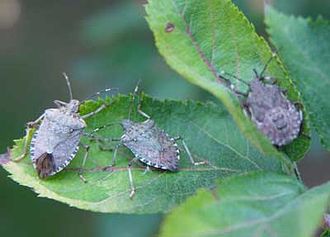 |
7
Climate is what to expect. Weather is what you get. Climate is basically a long-term average of what the weather has done in the past.
Knowing the climate helps the farmer plan agricultural activities such as planting and harvesting, as well as assisting in crop selection. Crops need to be in the ground early enough that they will be able to produce their yield before the first frost, but late enough to avoid springtime frosts. The climate tells the farmer how many growing days to expect, and that can be compared to the number of growing days required by various crops. Some crops also need to be harvested before the weather gets too hot, and other crops may allow multiple plantings and harvestings per season.
Weather also plays a hand in timing agricultural activities. A field needs to dry out before it is plowed, and then it may need to dry out for a few more days before it is disced. Dry weather is also needed to allow hay time to cure between mowing and bailing, and it is sometimes important when applying fertilizers or pesticides.
8
Your log need not be any more complicated than a notebook and pen. You could include information such as:
- Plowing/Discing
- When was it done?
- What was the condition of the soil?
- Cost
- Planting
- Date
- Amount of seed used
- Method (how was the planting done?)
- Cost
- Fertilizer
- When applied
- What kind was applied
- Cost
- Pest Control
- Dates and types of pesticides and herbicides
- Cultivation dates
- Mechanical/cultural controls applied
- Cost
- Irrigation
- Dates
- Rainfall dates
- Cost
- Harvest
- Date
- Yield
9
9a
The primary purpose of plowing is to turn over the upper layer of the soil, bringing fresh nutrients to the surface, while burying weeds and the remains of previous crops, allowing them to break down. It also aerates the soil, and allows it to hold moisture better. In modern use, a plowed field is typically left to dry out, and is then harrowed before planting.
9b
Disking is often carried out on fields to follow the rough finish left by plowing operations. The purpose of this is generally to break up clods and lumps of soil and to provide a finer finish, a good tilth or soil structure that is suitable for seeding and planting operations.
9c
A cultivator is a farm implement for stirring and pulverizing the soil, either before planting or to remove weeds and to aerate and loosen the soil after the crop has begun to grow.
9d
Irrigation is the artificial application of water to the soil for assisting in growing crops. In crop production it is mainly used in dry areas and in periods of rainfall shortfalls, but also to protect plants against frost.
9e
The purpose of harvesting is to collect the salable product grown in a field when it reaches maturity.
10
The greatest benefit birds provide to farmers is their voracious appetites for insects.
Please consult Wikibooks' Field Guide to Birds to help you identify ten birds in your area. As of this writing, this field guide is still in its infancy, so you might be well served to purchase a more thorough field guide. Field guides are generally tailored to a specific area of the world, so be sure to consult one that covers your area.
11
Erosion is the displacement of soil by wind, water, or ice by downward or down-slope movement. It can occur quickly on steep ground - especially if there is nothing growing there. It can be slowed by minimizing the amount of time the land has nothing growing on it. When plowing, discing, or planting, it is best to make furrows perpendicular to the slope of the ground. Plowing straight uphill will cause furrows to act as ever-widening ditches that channel the water quickly away, carrying soil with it. Plowing across a hill instead slows the descent of rainwater and allows it to drop the sediments it picks up rather than carrying it off.
12
USA
The Cooperative Extension Service, also known as the Extension Service of the USDA, is a non-formal educational program implemented in the United States designed to help people use research-based knowledge to improve their lives. The service is provided by the state's designated land-grant universities. In most states the educational offerings are in the areas of agriculture and food, home and family, the environment, community economic development, and youth and 4-H. The Cooperative State Research, Education, and Extension Service of the USDA administers funding for Smith Lever Act services in cooperation with state and county governments and land-grant universities.
This table summarizes the cooperative extension programs in each state. (Under the 1890 amendment to the Morrill Act, if a state's land-grant university was not open to all races, a separate land-grant university had to be established for each race. Hence, some states have more than one land-grant university.)
| State | University | Extension Website |
|---|---|---|
| Alabama | Alabama A&M University Auburn University Tuskegee University& |
Alabama Cooperative Extension System |
| Alaska | University of Alaska | University of Alaska Cooperative Extension |
| Arizona | University of Arizona | Arizona Cooperative Extension |
| Arkansas | University of Arkansas University of Arkansas at Pine Bluff |
University of Arkansas Cooperative Extension Service |
| California | University of California | University of California Cooperative Extension |
| Colorado | Colorado State University | Colorado State Cooperative Extension |
| Connecticut | University of Connecticut | Connecticut Cooperative Extension System |
| Delaware | University of Delaware Delaware State University |
Delaware Cooperative Extension DSU Cooperative Extension |
| District of Columbia | University of the District of Columbia | University of the District of Columbia Cooperative Extension Service |
| Florida | University of Florida Florida A&M University |
University of Florida IFAS Extension |
| Georgia | University of Georgia Fort Valley State University |
University of Georgia Cooperative Extension |
| Hawaii | University of Hawaii | University of Hawaii Cooperative Extension Service |
| Idaho | University of Idaho | University of Idaho Extension |
| Illinois | University of Illinois | University of Illinois Extension |
| Indiana | Purdue University | Purdue University Extension |
| Iowa | Iowa State University | Iowa State University Extension |
| Kansas | Kansas State University | Kansas State University Research & Extension |
| Kentucky | University of Kentucky | University of Kentucky Cooperative Extension Service |
| Louisiana | Louisiana State University Southern University and A&M College |
Louisiana Cooperative Extension Service |
| Maine | University of Maine | University of Maine Extension |
| Maryland | University of Maryland University of Maryland Eastern Shore |
Maryland Cooperative Extension |
| Massachusetts | University of Massachusetts | University of Massachusetts Extension |
| Michigan | Michigan State University | Michigan State University Extension |
| Minnesota | University of Minnesota | Minnesota Extension Service |
| Mississippi | Mississippi State University Alcorn State University |
Mississippi State University Extension |
| Missouri | University of Missouri Lincoln University |
University of Missouri Extension |
| Montana | Montana State University | Montana State University Extension Service |
| Nebraska | University of Nebraska | University of Nebraska Cooperative Extension |
| Nevada | University of Nevada | University of Nevada Cooperative Extension |
| New Hampshire | University of New Hampshire | University of New Hampshire Cooperative Extension |
| New Jersey | Rutgers University | Rutgers Cooperative Extension |
| New Mexico | New Mexico State University | New Mexico State University Cooperative Extension Service |
| New York | Cornell University | Cornell Cooperative Extension |
| North Carolina | North Carolina State University North Carolina A&T State University |
North Carolina Cooperative Extension Service North Carolina A&T State University Cooperative Extension Program |
| North Dakota | North Dakota State University | North Dakota State University Extension Service |
| Ohio | Ohio State University | The Ohio State University Extension |
| Oklahoma | Oklahoma State University | Oklahoma Cooperative Extension Service |
| Oregon | Oregon State University | Oregon State University Extension Service |
| Pennsylvania | Penn State | Penn State Cooperative Extension |
| Rhode Island | University of Rhode Island | University of Rhode Island Cooperative Extension |
| South Carolina | Clemson University South Carolina State University |
Clemson University Cooperative Extension Service |
| South Dakota | South Dakota State University | South Dakota State University Cooperative Extension Service |
| Tennessee | University of Tennessee Tennessee State University |
University of Tennessee Extension Tennessee State University Cooperative Extension Program |
| Texas | Texas A&M University Prairie View A&M University |
Texas AgriLife Extension Service |
| Utah | Utah State University | Utah State University Extension |
| Vermont | University of Vermont | University of Vermont Extension System |
| Virginia | Virginia Tech Virginia State University |
Virginia Cooperative Extension |
| Washington | Washington State University | Washington State University Extension |
| West Virginia | West Virginia University | West Virginia University Extension Service |
| Wisconsin | University of Wisconsin-Extension | University of Wisconsin Extension |
| Wyoming | University of Wyoming | University of Wyoming Cooperative Extension Service |
Canada
Agriculture extension (the process of sharing agricultural research with the farming community) is the responsibility of provincial governments in Canada. Contact your Provincial Ministry of Agriculture for contact information for the appropriate office near you.
References
- ↑ http://www.csrees.usda.gov/qlinks/partners/partners_list.pdf Retrieve 2007-10-22.
- ↑ Although Tuskeegee University has been a private university, it began to receive Cooperative Extension funding in 1972.
Content on this wiki is generated by people like you, and no one has created a lesson plan for this honor yet. You could do that and make the world a better place.
See AY Honors/Model Lesson Plan if you need ideas for creating one.
